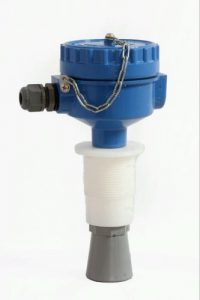















Sonic is the sound we can hear. Ultrasonic is the sound above human hearing range. Human can hear maximum up to a frequency of 20 KHz. Ultrasonic frequencies are above 20 KHz. Ultrasonic waves are used to measure level of liquids and solid objects in industries. Ultrasonic level measurement is contactless principle and most suitable for level measurements of hot, corrosive and boiling liquids. The normal frequency range used for ultrasonic level measurements is within a range of 40 200 KHz.
Principle:- The emitter in the sensor is excited electrically and sends an ultrasonic pulse in the direction of the surface of the product which partially reflects the pulse. Thus echo is detected by the same sensor, now acting as a directional microphone, and converted into a electrical signal. The transmission and reception of the pulse (the sonic run time) is directly proportional to the distance between the sensor and the product surface.
An ultrasonic level transmitter is fixed at the top of a tank half filled with liquid. The reference level for all measurements is the bottom of the tank. Level to be detected is marked as “C”, and “B” is the distance of the ultrasonic sensor from the liquid level. Ultrasonic pulse signals are transmitted from the transmitter, and it is reflected back to the sensor. Travel time of the ultrasonic pulse from sensor to target and back is calculated. Level “C” can be found by multiplying half of this time with the speed of sound in air. The measuring unit final result can be centimeters, feet, inches etc.
Level = Speed of sound in air x Time delay / 2





Problem in Ultrasonic Transmitter
1. Calibration of the transmitter is crucial. Accuracy of measurement depends on the accuracy of calibration. The Empty distance “A” and measurement span “D” is to be ascertained correctly for inclusion in calibration of the transmitter.
2. The transient characteristics of the sensor will develop a Blocking distance. Span “D” should never extend to the blocking distance.
3. There are some interference echoes developed by the edges, welded joints etc. This is taken care by the software of the transmitter and called interference echo suppression
4. Velocity of sound changes due to the variation of air temperature. An integrated temperature sensor is used to compensate for changes in velocity of sound due to temperature variations.
Advantages of Ultrasonic Level Transmitter:
- 1:- Direct installation on tanks, vessels and reactors
- 2:- Full compensation in virtually all environments
- 3:- Delivers highest accuracy even under harsh conditions
- 4:- Self-calibration to virtually all types of conditions
- 5:- Maintenance-free
Limitations of Ultrasonic Level Transmitter:
1. it is not so convenient in High Depth Tank.
2. It is not suitable for smoky Enviroment.
3. The object should not be sound absorbing type
4. It is not so convenient if echo is absorbed or dispersed.
5. It is not suitable for high Density moisture.
Application
1:- Hazardous Chemical level
2:- Solid level
3:-Acid level
4:-Variable density material level.